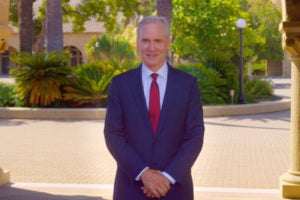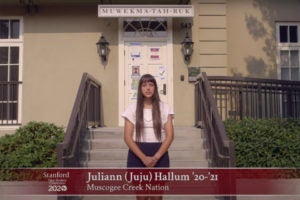Virtual Convocation marks the beginning of an unusual academic year

Even as they study from afar because of the COVID-19 pandemic, new first-year students and transfers were encouraged to stay connected to the Stanford campus community.
Calling it “anything but a normal year,” President Marc Tessier-Lavigne urged new students to “support and check in on one another, just as you would were you on campus.”
He added, “Even though we must be physically distant from one another, we can still build and sustain our relationships. Our campus is beautiful, but it is our community that makes Stanford so special.”
That was one of three thoughts the president shared during a virtual Convocation that streamed Wednesday. The president was one of seven speakers who spoke from various Stanford locations to give new students and their families a sense of the campus. Tessier-Lavigne spoke from beneath the arches in Memorial Court.
In his remarks, the president acknowledged that Convocation, which marks the beginning of the academic year and of New Student Orientation, is generally held at the end of an exuberant move-in day and in the confines of Stanford’s iconic Main Quad with new students and their families in attendance.
“You are beginning your university careers at a very challenging time,” he said. “The coronavirus pandemic has deeply affected communities across our nation and our world and, of course, here at Stanford. I know how difficult it is that most of you are beginning your Stanford journeys from a distance. I truly wish I were meeting you in person today. And I can assure you that we can’t wait to bring you to campus just as soon as possible.”
Words of advice
Despite the challenges of the coming quarter, the president encouraged new students to explore widely the academic opportunities available at Stanford and to avoid focusing on pre-major studies out of uncertainty about the future.
“Gaining knowledge and skills from a number of different fields is the best preparation for the world that will emerge when the pandemic recedes – and for the decades of change that we know will follow,” Tessier-Lavigne said.
The president also encouraged new students to learn from one another, noting that the Stanford community may be the most diverse many of them have ever – or will ever – experience.
“That means that this is an extraordinary opportunity to think critically about your own views and preconceptions – and deepen your thinking about our society and our world,” he said. “In addition, we’ve all heard the cry for racial justice that has been ringing across our nation. We know how much more work remains to be done to improve equity in our nation and in our communities. That includes Stanford.”
Stanford, he said, is acting with “urgency to create a more inclusive, accessible, diverse and equitable university” and will share initiatives designed to do that in the coming year.
New student profile
Although they are studying during a time vastly different from their Stanford predecessors, statistics provided by Richard Shaw, dean of admission and financial aid, indicate this year’s new students share a profile similar to that of previous cohorts.
New students hail from all 50 states and from 55 different countries. Collectively, they speak 63 unique languages in addition to English. They attended 1,234 high schools and are transferring from 59 different colleges. Ten percent of the new students are international citizens, and 20 percent are the first in their families to attend a four-year university. The class is 52 percent women and 48 percent men.
Shaw, who spoke from Jane Stanford Way in front of the Main Quad, credited the new students with shouldering challenges they did not choose, while remaining “bold, brave, resilient and unstoppable.”
Land acknowledgment
The ceremony began with a welcome and invocation by Dean for Religious Life Rev. Dr. Tiffany Steinwert, speaking before Memorial Church, and a land acknowledgment by Juliann “JuJu” Hallum, ’20. In that acknowledgment, Hallum noted that Stanford is located on the ancestral and unceded land of the Muwekma Ohlone Tribe.

Speaking for the first time at Convocation were Sarah Church, who became vice provost for undergraduate education in June, and Mona Hicks, who became senior associate vice provost and dean of students in winter quarter.
Church, who spoke from Meyer Green, applauded incoming students for their resilience and persistence amidst uncertainty and described the work faculty have invested in ensuring excellence in online teaching.
“Faculty, instructors and staff are working diligently to make sure your first year at Stanford is instructive, collaborative, meaningful and memorable, even from afar,” she said.
Church encouraged students to be kind to themselves and to recognize that everyone struggles at one time or another in college.
“Truly, this happens to almost all students in one way or another, including me when I was in your position,” she said. “Be kind to yourselves in these moments and realize that there are resources in place to help support you.”
Hicks, who spoke from the front of Old Union, encouraged students to capitalize on the reflection that challenging times prompt. Students, she said, should reflect on the deeper meaning of their callings in life, knowing that Stanford will provide needed support.
Bittersweet moment
Also speaking was Vianna Vo, ’21, president of the Associated Students of Stanford University. Vo noted that she would normally be reminiscing with new students about her days moving-in at Stanford and sitting through Convocation.

Vianna Vo, ’21, president of the Associated Students of Stanford University, shared her academic transitions and acknowledged challenges to mental health. (Image credit: Andrew Brodhead)
“I want to acknowledge that this may be a bittersweet moment for you,” she said. “It is for me. But I also know that today, you are joining Stanford as our newest cohort. Stanford has been so much more than just a college to me. It’s become a place I call home.”
Vo shared her academic transitions at Stanford and her challenges with depression. For Vo, her participation with the student group Taiko provided the support and sense of belonging she needed to persevere. She encouraged new students to seek out similar student communities – despite the awkwardness caused by remote auditions and connections – and to embrace the passions they may discover here.
“I was able to regain my footing,” she said.” In my sophomore year, I joined ASSU and set my mind to changing the conversation around mental health on campus. Before I knew it, three years had passed. My interests have changed, and I know now that advocacy is where my passion lies.”
